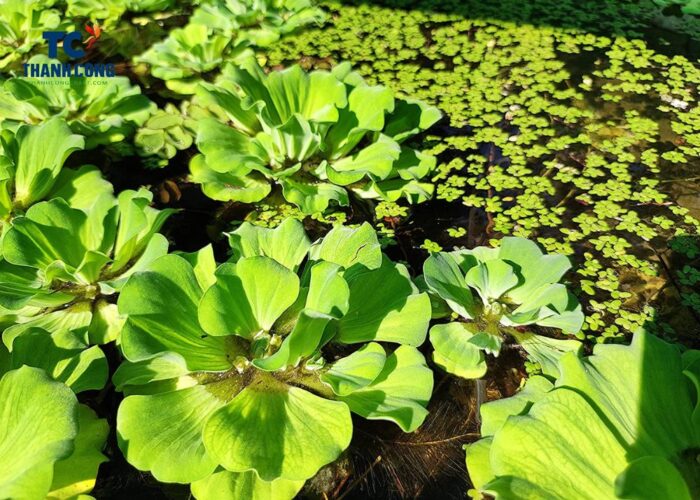-
10-02-2023, 04:19 PM #1
 Silver member
Silver member

- Ngày tham gia
- Jul 2023
- Bài viết
- 163
Water lettuce vs water hyacinth Comparison
Water lettuce vs water hyacinth

Water lettuce vs water hyacinth: Water lettuce (Pistia stratiotes) and water hyacinth (Eichhornia crassipes) are both aquatic plants, but they have some key differences:
Appearance:- Water Lettuce: Water lettuce has light green, rosette-shaped leaves that resemble lettuce leaves, hence the name. The leaves are often covered in fine hairs, giving them a fuzzy appearance. The plants float on the water's surface, with their roots hanging below.
- Water Hyacinth: Water hyacinth has glossy, dark green leaves that are thicker and more bulbous. They also float on the water's surface, and they produce long stalks with attractive lavender to violet flowers. The plants have bulbous, inflated leaf petioles that help them stay afloat.
Reproduction:- Water Lettuce: Water lettuce reproduces primarily through the formation of daughter plants or offsets. These small plantlets develop at the base of the mother plant and eventually detach to grow independently.
- Water Hyacinth: Water hyacinth reproduces through both seeds and vegetative means. It can produce prolific numbers of seeds, but it also forms daughter plants, which can lead to rapid spreading in aquatic ecosystems.
Invasiveness:- Water Lettuce: While water lettuce can be invasive in some regions, it is generally considered less aggressive than water hyacinth. It tends to grow more slowly and can be easier to control.
- Water Hyacinth: Water hyacinth is known for its invasive nature and rapid growth. It can form dense mats on the water's surface, which can block sunlight and oxygen from reaching the water, causing harm to aquatic ecosystems and disrupting waterways.
Ecological Impact:- Water Lettuce: Water lettuce can provide some benefits to aquatic ecosystems by providing shade and habitat for small aquatic organisms. However, it can also negatively impact water quality if it becomes too dense.
- Water Hyacinth: Water hyacinth is often considered a more serious threat to aquatic ecosystems. Its rapid growth can lead to oxygen depletion in the water, fish kills, and the displacement of native aquatic plants. It can also impede navigation and water resource management.
Control:- Both water lettuce and water hyacinth can be controlled through physical removal, such as manual or mechanical harvesting. Additionally, chemical control methods can be used, but they must be carefully managed to avoid harming non-target species and the environment.
In summary, water lettuce and water hyacinth are two different aquatic plants with distinct appearances, reproductive strategies, and ecological impacts. Water hyacinth is generally more invasive and problematic in aquatic environments, while water lettuce is considered less aggressive but still requires management in some cases.
Check out for more: https://thanhcongcraft.com/how-diffe...ater-hyacinth/Chủ đề cùng chuyên mục:
- Stay Organized in Style with Bamboo Card Holders
- How to Weave a Basket with Palm Leaves: A Step-by-Step Guide
- Embrace Organic Elegance: Woven Bamboo Baskets for Stylish Storage
- Creative Gift Basket Wrapping: Elegant Alternatives to Cellophane?
- Spark Imagination and Creativity with the Rattan Play Kitchen
- Small Rattan Coffee Table: Adding Rustic Charm to Your Living Space
- How to Make a Stunning Twig Star for Your Home Decor
- Top địa chỉ in tranh vân đá giá rẻ, đẹp tại TP.HCM
- Elevate Your Table Setting with Round Rattan Placemats
- DIY Guide: How to Make Willow Charcoal for Art and Crafting
Có thể bạn quan tâm:
-
How to clean water hyacinth baskets?
Bởi Thanhcongcraft trong diễn đàn Nội Ngoại ThấtTrả lời: 0Bài viết cuối: 09-25-2023, 04:14 PM -
Organize Naturally: Water Hyacinth Storage Solutions
Bởi Thanhcongcraft trong diễn đàn Nội Ngoại ThấtTrả lời: 0Bài viết cuối: 09-15-2023, 03:30 PM -
Sustainable Style: Round Water Hyacinth Basket
Bởi Thanhcongcraft trong diễn đàn Nội Ngoại ThấtTrả lời: 0Bài viết cuối: 08-23-2023, 01:55 PM -
Water Hyacinth Rectangle Basket - the indispensable household items
Bởi Thanhcongcraft trong diễn đàn Nội Ngoại ThấtTrả lời: 0Bài viết cuối: 07-28-2023, 12:01 PM -
Nature's Abundance: Extra Large Water Hyacinth Basket
Bởi Thanhcongcraft trong diễn đàn Nội Ngoại ThấtTrả lời: 0Bài viết cuối: 07-27-2023, 11:52 AM



 Trả lời kèm Trích dẫn
Trả lời kèm Trích dẫn




Vệ sinh cá nhân chủ nghĩa là một phần quan trọng của sức khỏe nam giới. Dùng dung dịch vệ sinh mỗi ngày mang lại nhiều ích, giúp loại bỏ vi khuẩn và vi sinh vật gây hại, giúp khu vực cơ quan sinh dục...
Dung dịch vệ sinh dương vật, các...